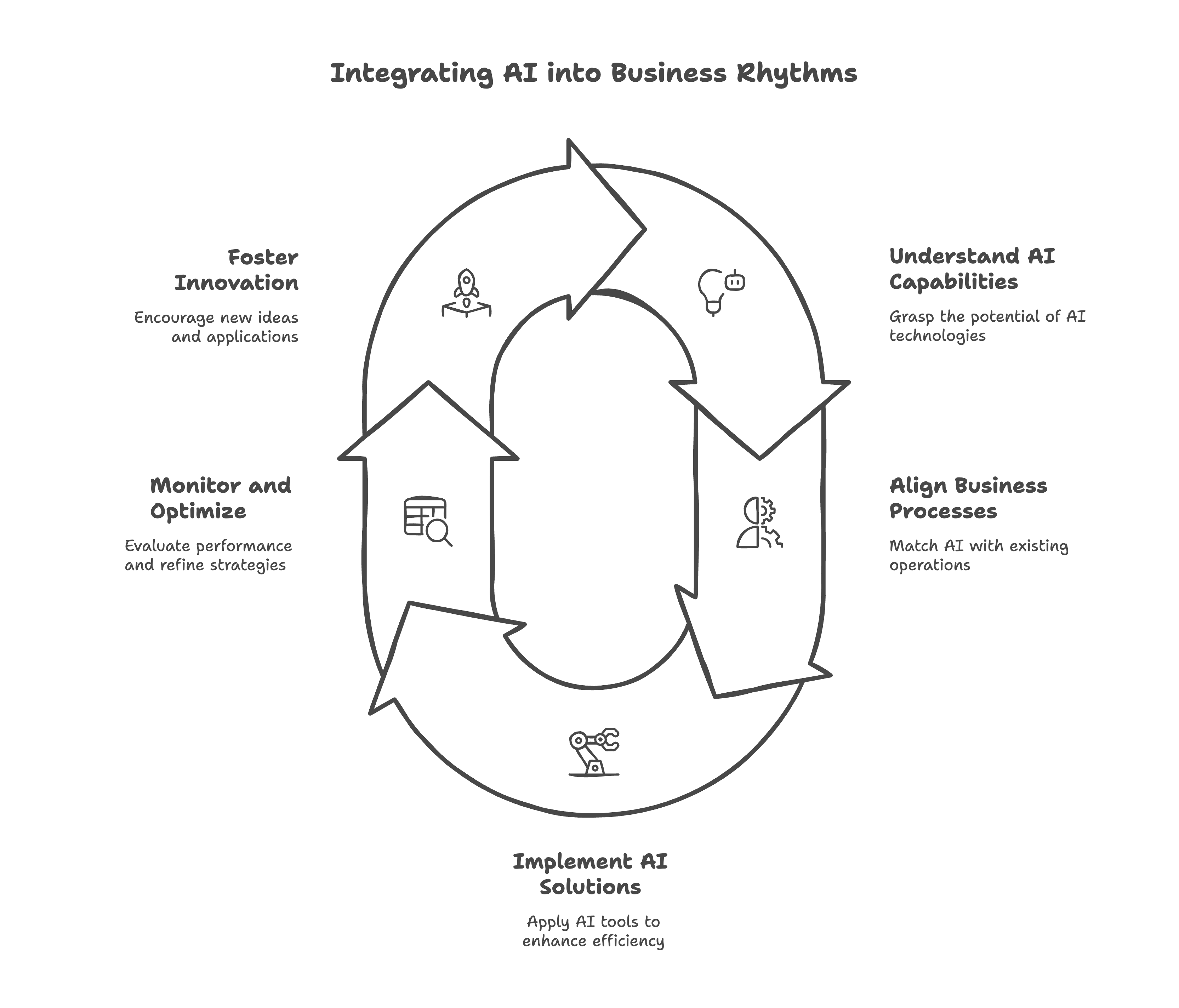TL;DR
Setting up business rhythms with AI —regular cadences of goal‑setting, reviews, and adjustment—unlock alignment, accountability, and predictable execution.. Layering AI on top of your goals, calendar, and meeting cadences turns manual check‑ins into an intelligence engine that spots trends, flags risks, and drafts insights so your team focuses on decisions, not data gathering.
Why Business Rhythms Matter
A well‑tuned business rhythm is the operating system of your organization. It:
-
Aligns around clear goals. Everyone knows what success looks like each week, month, and quarter.
-
Builds accountability. Regular check‑ins keep work visible and owners proactive.
-
Creates predictability. Consistent cadences reveal patterns, enabling data‑driven adjustments.
-
Fosters continuous learning. Each cycle surfaces improvements, accelerating team maturity.
Without a rhythm, goals slip through the cracks, meetings stagnate, and strategy drifts from reality.
Step 1: Define and Connect Your Goals
-
Articulate Objectives & Key Results (OKRs/KPIs). Pick 2–4 high‑leverage objectives per cycle (week, month, quarter).
-
Assign Clear Ownership. Ensure each goal has a dedicated owner responsible for progress and outcomes.
-
Link to Data Sources. Map each KR to one or more systems (e.g., CRM for revenue, analytics for engagement, issue trackers for delivery).
Pro Tip: Use Brev to register goals once—then AI will continuously pull real‑time signals against them.
Step 2: Map Your Calendar & Cadences
-
Set Core Cadences. Define your Weekly Business Review (WBR), Monthly Business Review (MBR), and Quarterly Business Review (QBR) slots in the calendar.
-
Embed Pre‑Reads. Block time 24 hours before each meeting for stakeholders to review AI‑generated summaries.
-
Rotate Facilitators. Give each function (e.g., product, marketing, sales) a chance to lead the WBR to surface cross‑team perspectives.
Why It Works: A shared calendar habit turns checkpoints from “optional” discussions into unmissable operating milestones.
Step 3: Integrate Your Data & Collaboration Tools
-
Connect Task Trackers & Repos. Link Jira, GitHub, Asana, or your developer workflow so AI can see what shipped versus plan.
-
Tap Sales & Support Streams. Hook up CRM and support ticketing to surface revenue shifts and customer signals.
-
Bring in Analytics. Connect your product or web analytics provider to track usage, adoption, and retention metrics.
These integrations feed your AI layer with the freshest data—no manual spreadsheets.
Step 4: Layer on AI‑Driven Insights
-
Automated Trend Detection. AI spots when progress deviates from targets or when a metric spikes/dips unexpectedly.
-
Risk & Dependency Flags. Unfinished tickets, overdue tasks, or overlapping workstreams get surfaced before they derail your week.
-
Drafted Narratives. Wins, misses, and next steps are written for you in the format your team loves (bullet lists, narrative slide copy, or Slack summary).
Benefit: Your team spends 80% less time compiling data and 100% more time on discussion and problem‑solving.
Step 5: Automate Review Preparation
-
Auto‑Generate Slide Decks. Branded WBR decks appear in your shared drive or collaboration tool minutes before the meeting.
-
Smart Reminders. Owners get nudges 24 hours before the review with their section draft and any missing inputs.
-
One‑Click Publish. After edits, the final report auto‑publishes to your stakeholders with decision logs.
This end‑to‑end workflow eliminates last‑minute scrambles and version chaos.
Step 6: Capture Decisions & Action Items
-
Decision Log. Every call-out and assignment gets recorded—“What, Why, Who, When.”
-
Automated Follow‑Ups. AI schedules reminders on unresolved action items before the next WBR.
-
Contextual Linking. Decisions link back to the relevant PRs, tickets, or docs for fast deep dives.
Over time, your rhythm archive becomes a living knowledge base—essential for onboarding and auditability.
Step 7: Monitor, Learn & Iterate Your Business Rhythms with AI
-
Pulse Surveys. After each WBR, a one‑question poll gauges value and surfaces improvement ideas.
-
Quarterly Retrospectives. Review cadence effectiveness: trim or add agenda items based on evolving priorities.
-
Template Evolution. Let AI adapt your WBR structure automatically—keeping it fresh and laser‑focused.
Continuous refinement ensures your rhythm scales with business complexity.
The Ongoing Value of Your Business Rhythms with AI
By weaving AI into your business rhythms, you unlock:
-
Sharper Alignment: Goals and workstreams stay in lockstep.
-
Faster Course‑Corrections: Risks and drift get addressed in real time.
-
Higher Execution Velocity: Teams spend time acting, not updating.
-
Richer Insights: Pattern detection and root‑cause analysis become second nature.
In essence, AI‑powered rhythms transform meetings from reactive status checks into proactive intelligence forums.
Next Steps to Get Started
-
Define Your Foundation: Pick your top goals for the upcoming week, month, and quarter.
-
Schedule Your Cadences: Block recurring WBR, MBR, and QBR slots in your shared calendar.
-
Connect & Activate AI: Link Brev to your key tools, approve your first AI‑generated WBR, and watch your rhythm come alive.
Ready to set up your business rhythms with AI and make your operating cadence self‑driving? Try Brev today and turn every meeting into a high‑velocity planning and decision hub.
